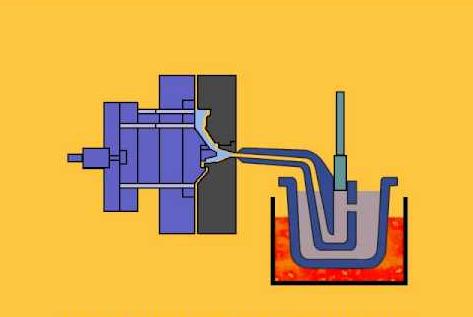There are various alloys that can be used for hot chamber die casting, here we’ll list some commonly used aluminum and zinc alloys in the process.

Common Aluminum Alloys Used in Hot Chamber Die Casting
Aluminum alloys are commonly used for hot chamber die casting due to their excellent strength, lightweight, and high thermal conductivity.
– A380: This is the most commonly used aluminum alloy for die casting. It has excellent fluidity, and pressure tightness, and is used in a wide range of applications, including automotive and appliance parts.
– A383: This alloy has better corrosion resistance and higher mechanical properties than A380. It is often used for complex shaped parts and components that require high strength.
– A360: This alloy has excellent pressure tightness and corrosion resistance. It is commonly used for parts that require a high surface finish, such as automotive wheels and decorative parts.
– A413: This alloy has good mechanical properties, and excellent pressure tightness, and is often used for parts that require high strength and lightweight, such as aerospace and defense components.
– ADC12: This alloy has good castability and excellent mechanical properties. It is commonly used for automotive and motorcycle parts, such as engine blocks and transmission cases.
Common Zinc Alloys Used in Hot Chamber Die Casting
– Zamak 3: This alloy is the most commonly used zinc alloy for hot chamber die casting. It has excellent castability, and good mechanical properties, and is suitable for a wide range of applications.
– Zamak 5: This alloy is similar to Zamak 3, but with higher levels of copper and magnesium, which give it improved strength and hardness.
– Zamak 2: This alloy has a high copper content, which gives it excellent strength and hardness. It is often used for parts that require high wear resistance.
– ZA-8: This alloy is a higher-strength alternative to Zamak 3, with improved creep resistance and dimensional stability.
– ZA-12: This alloy has higher levels of aluminum and copper, which give it improved strength, hardness, and corrosion resistance. It is often used for parts that require high toughness and ductility.
– ZA-27: This alloy has the highest strength and hardness of any zinc alloy, making it suitable for applications that require high strength and wear resistance.
How to Choose the Best Alloys for Hot Chamber Die Casting
The selection of an alloy for hot chamber die casting depends on several factors, including the specific requirements of the part being produced, such as its mechanical properties, surface finish, and dimensional accuracy. Here are some factors to consider when selecting an alloy for hot chamber die casting:
– Mechanical properties: Consider the required strength, hardness, and toughness of the part. Some alloys have higher strength or better wear resistance, while others are more ductile or have better impact resistance.
– Surface finish: Consider the required surface finish of the part. Some alloys are better suited for high-quality surface finishes, while others may have a more matte or textured finish.
– Dimensional accuracy: Consider the required dimensional accuracy and stability of the part. Some alloys have better dimensional stability and lower shrinkage rates, resulting in less warping and better part-to-part consistency.
– Corrosion resistance: Consider the operating environment of the part and its exposure to corrosion or other environmental factors. Some alloys have better corrosion resistance than others.
– Cost: Consider the cost of the alloy, as some alloys may be more expensive than others.

